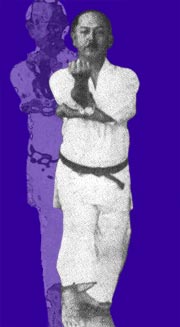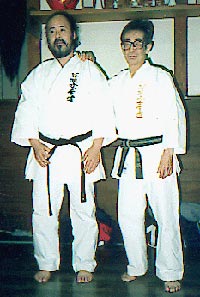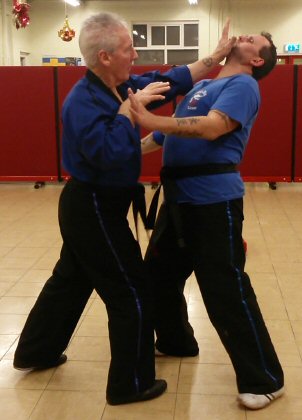The Association is a small family group keeping all the traditional basics.
The Shukokai Karate Syllabus we use is based on the teaching of Sensei Kimura, and the S.K.U. of the 70's and mid 80's.
Which is made up of 10 A's, 10 B's, and 10 C's, Shukokai combinations,
12 Kata's up to 1st Dan. plus numerous other advanced Kata,
Hokei Kumite's 5 A's, 5 B's, and 5 C's.
Kicking combinations, Stance training, Kumite (sparring), Ippon Kumite, Pad work, also keen on involving our students in competition within our group, open competitions, and within F.E.K.O.
The History of Shukokai Karate
Shukokai Karate, the "Way for All", is a traditional system of Okinawan Karate, which has evolved from careful analysis of the dynamics and principles of traditional karate. The lineage of Shukokai can be considered a direct descendant of it's parent style, Shito Ryu. Shito Ryu Karate is accredited to Soke Kenwa Mabuni (1890-1952).

Mabuni, like many of the old karate masters, was descended from the Okinawan warrior class, or bushi. Mabuni family members had served Okinawan lords for hundreds of years. At 13, Mabuni became a student of Yasutsune "Ankou" Itosu (1830-1915). Itosu taught Okinawan Shuri-Te and was credited as the master who developed the Pinan Kata and was instrumental in organising early karate into the Okinawan school system. Itosu himself was a student of one of Okinawa's most famous karate masters, Sokon Matsumura (1792-1887), the forefather of Shorin-Ryu. During his teens, Mabuni also studied under Kanryo Higa (ashi) onna (1853-1915), a teacher of Naha-Te, a particularly Chinese influenced karate style. Mabuni was introduced to Higaonna by his friend, Chojun Miyagi (who went on to become the founder of Goju-Ryu karate). At this time, Mabuni was a highly respected police officer, and often visited Japan following Funakoshi's introduction of karate there in 1922. In 1929, Mabuni relocated permanently to Osaka. Just after he took up residence there, the governing body for martial arts in Japan, the Butokukai, enforced that all karate schools should officially register by their style name. Initially, Mabuni named his style Hanko, meaning "half-hard", but by the early 1930s, he was using the name Shito-Ryu. Mabuni lived in Osaka until 1952, devoting his life to promoting his Shito-Ryu Karate. It was during this lifetime that one of his students, Chojiro Tani was to further refine the style, into Shukokai Karate. Chojiro Tani was born in Kobe, Japan in 1921 and began studying the art of Karate during Junior High School at the Gojo School of Karate. He entered Doshisha University in 1940 and furthered his studies of karate under the direction of Ken-na Mabuni. Upon receiving his Menko (Teachers Certificate) from Kenwa Mabuni, Sensei Tani began teaching Tani-Ha Shito Ryu at his own Dojo. He proudly hung a wood carved sign above the entrance which said Shukokai - "Way for All". He also organised clubs in Kyoto University and Osaka College of Economics, Tottiro University and Kobe University Medical School. Outside of Japan, Tani's style spread mainly in Europe (Kofukan International). Shigeru Kimura, one of the students of Chojiro Tani then took Shukokai to Africa and the United States, whilst Yoshinao Nambu continued to teach in Europe. When Sensei Tani retired as Chief Technical Director he appointed Shigeru Kimura, 9th Dan, (1941-1995) as his successor. Photo - Sensei Kimura (L) and Sensei Tani (R)

Kimura Sensei had won the World All-Styles Championship when only 21 years of age and had twice been the All-Japan Champion before retiring from active competition. Sensei Kimura established a reputation of master level Shukokai Karate throughout the world. Being a direct descendent of Shito-Ryu, Shukokai inherits the characteristics of both the Naha-te and Shuri-te styles of Okinawan Karate. While Shukokai shares many of the same punches, kicks, and blocks found in other popular styles of Karate, it is in how these are executed that sets Shukokai apart. Sensei Tani and Sensei Kimura made their greatest contributions to the style by continually refining each technique to the highest degree, essentially re-defining the basics that had been practiced for centuries. Both made the study of body mechanics their primary focus with the end result being the delivery of the greatest impact with the least amount of effort. Another defining characteristic is that each technique must be combat effective. Sensei Kimura believed that a technique, no matter how powerful, was useless if it could not be delivered under combat situations. His philosophy was that the outcome of a confrontation should be decided in a single technique, one hit one kill, which was the traditional way of the Samurai. This drove him to continually modify and test his technique throughout the course of his life with the end result being the traditional, yet combat effective style of Karate we call Shukokai. Every technique executed within Shukokai has these principles at its core.
English Japanese Say Do
one ichi itchy Scratch your
two ni knee Knee
three san Sun Point to sky
four shi she Point to girl
five go go Walk
six roku rock Rock 'n' Roll
seven shichi shi-chi Double Sneeze (She-chy)
eight hachi hat-chi Put on hat
nine kyu coo Coo like a dove
ten ju ju Chew (or don Jewish cap)


